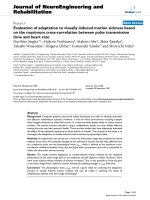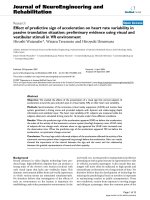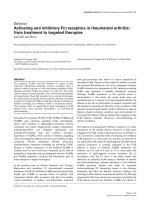Assessment and quantification of foetal electrocardiography and heart rate variability of normal foetuses from early to late gestational periodsb 1
Bạn đang xem bản rút gọn của tài liệu. Xem và tải ngay bản đầy đủ của tài liệu tại đây (2.86 MB, 98 trang )
ASSESSMENT AND QUANTIFICATION OF FOETAL
ELECTROCARDIOGRAPHY AND HEART RATE
VARIABILITY OF NORMAL FOETUSES FROM EARLY
TO LATE GESTATIONAL PERIOD
ELAINE CHIA EE LING
(B.Sc. (Hons.), NUS)
A THESIS SUBMITTED FOR THE DEGREE OF DOCTOR OF
PHILOSOPHY
DEPARTMENT OF PHYSIOLOGY
NATIONAL UNIVERSITY OF SINGAPORE
2006
Acknowledgements i
ACKNOWLEDGEMENTS
I would like to express my sincere gratitude to the following people,
without whose contributions this thesis would not have been possible:
• A/Prof. Ho Ting Fei for the invaluable guidance, advice and
encouragement that she has provided me throughout my time as her PhD
student.
• A/Prof. William Yip for his helpful discussions and comments.
• A/Prof. Mary Rauff for her guidance and for kindly allowing me to
conduct the study at her clinic.
• Dr. Chang Ee-Chien and Gao Ping from the Department of Computer
Science for their help in the development of F-EXTRACT.
• Dr. Zhang Niu for her assistance in acquiring the intrapartum ECG.
• A/Prof. YC Wong, A/Prof. PC Wong and A/Prof. Roy Joseph for their
help in this study.
• Mdm Heng Ye Yong for her assistance in various technical aspects of the
study.
• All patients who participated in this longitudinal study by allowing serial
foetal ECG to be recorded during each antenatal visit.
• The nursing and reception staff of NUH Women’s Clinic Emerald for their
help in patient recruitment and follow-up, as well as in assessing patients’
medical records.
• The admin staff of Department of Physiology for their secretarial support.
Publications ii
PUBLICATIONS
The following publications have resulted from the present study:
International Referred Journals:
1) Chia EL, Ho TF, Rauff M, Yip WCL. Cardiac time intervals of normal fetuses
using noninvasive fetal electrocardiography. Prenat Diagn. 2005; 25(7): 546-52.
2) Chia EL, Ho TF, Wong YC, Yip WCL. Ventricular bigeminy misdiagnosed as
fetal bradycardia by cardiotocography- the value of non-invasive fetal
electrocardiography. J Perinat Med. 2004; 32(6): 532-4.
Conference Paper:
1) Chia EL, Ho TF, Rauff M, Yip WCL. Cardiac time intervals of normal fetuses
using non-invasive fetal electrocardiography. NHG Annual Scientific Congress;
October 9, 2004; Singapore.
Table of Contents iii
TABLE OF CONTENTS
ACKNOWLEDGMENTS……………………………………………………… i
PUBLICATIONS………………………………………………………………. ii
TABLE OF CONTENTS………………………………………………………. iii
SUMMARY……………………………………………………………………. x
LIST OF TABLES…………………………………………………………… xiii
LIST OF FIGURES……………………………………………………………. xiv
LIST OF ABBREVIATIONS………………………………………………… xvi
Chapter 1 The foetal electrocardiogram……………………………… 1
1 Historical development of the foetal ECG…………………………… 2
2 Measurement of the foetal ECG……………………………………… 4
2.1 Invasive techniques - foetal scalp electrodes………………… 4
2.1.1 Clinical application of scalp foetal ECG………… 5
2.2 Non-invasive techniques - maternal abdominal electrodes… 6
2.2.1 Foetal ECG studies utilizing abdominal electrodes… 6
2.2.2 Technical difficulties with abdominal electrodes… 7
2.2.3 Vernix caseosa and abdominal foetal ECG signal… 8
2.2.4 Acquisition and processing of abdominal foetal
ECG………………………………………………… 11
2.2.5 Clinical application of abdominal foetal ECG…… 13
Chapter 2 The foetal ECG waveform………………………………… 14
1 Morphology and time intervals of the foetal ECG……………………. 15
1.1 P wave………………………………………………………. 15
Table of Contents iv
1.2 PR interval………………………………………………… 18
1.3 QRS complex……………………………………………… 21
1.4 QT interval………………………………………………… 23
1.5 ST segment………………………………………………… 25
1.6 T wave………………………………………………………. 25
2 Foetal ST segment and T wave- Animal studies……………………… 26
3 Foetal ST segment and T wave- Human studies……………………… 31
Chapter 3 Heart rate variability……………………………………… 35
1 Definition of heart rate variability……………………………………. 36
2 History of heart rate variability………………………………………. 36
3 Measurement of heart rate variability……………………………… 37
3.1 Time-domain methods……………………………………… 38
3.2 Frequency-domain methods………………………………… 40
3.3 Geometrical methods……………………………………… 44
3.4 Non-linear methods…………………………………………. 47
4 Physiological significance of heart rate variability………………… 48
4.1 Components of heart rate variability……………………… 49
4.2 Estimate of vagal activity…………………………………… 50
4.3 Estimate of sympathetic activity……………………………. 51
4.4 Estimate of sympatho-vagal balance………………………… 52
5 Factors affecting HRV………………………………………………… 52
6 Clinical application of heart rate variability…………………………… 53
Table of Contents v
Chapter 4 Heart rate variability in the foetus………………………… 57
1 Development of the foetal heart rate………………………………… 58
2 Regulation of the foetal heart rate…………………………………… 60
2.1 Regulation by the sympathetic nervous system…………… 61
2.2 Regulation by the parasympathetic nervous system…………. 61
2.3 Central control of foetal heart rate………………………… 62
2.4 Different maturation rates of the autonomic branches………. 63
3 Causes of foetal heart rate variability… …………………………… 64
4 Measurement of foetal HRV………………………………………… 65
5 Characteristics of foetal HRV…………………………………………. 67
6 Factors affecting foetal heart rate variability………………………… 68
6.1 Gestational age………………………………………………. 68
6.2 Hypoxia……………………………………………………… 68
6.3 Foetal activity……………………………………………… 69
6.4 Foetal breathing movements………………………………… 70
6.5 Drugs………………………………………………………… 71
7 Clinical significance of foetal heart rate variability………………… 72
Chapter 5 Scope of study……………………………………………… 75
1 Background…………………………………………………………… 76
2 Hypotheses……………………………………………………………. 77
3 Aims and objectives………………………………………………… 77
Chapter 6 Materials and methods…………………………………… 80
1 Patient selection………………………………………………………. 81
Table of Contents vi
1.1 Study subjects………………………………………………. 81
1.2 Exclusion criteria…………………………………………… 81
1.3 Patient withdrawal………………………………………… 81
2 Methodology………………………………………………………… 82
2.1 Foetal ECG acquisition procedures………………………… 82
2.2 Foetal ECG equipment description and operation………… 86
2.3 Measurement of foetal ECG parameters……………………. 91
2.4 Neonatal ECG acquisition and measurement………………. 93
2.5 Foetal HRV measurement………………………………… 94
2.6 Comparison of F-EXTRACT and Nevrokard HRV
softwares…………………………………………………… 96
2.7 Correction of aberrant beats……………………………… 97
2.8 Statistics……………………………………………………. 97
Chapter 7 Cardiac time intervals of healthy foetuses……………… 98
1
2
3
4
5
6
Introduction…………………………………………………………. 99
Study population……………………………………………………. 101
Method……………………………………………………………… 103
Results………………………………………………………………. 103
4.1 Success rates of foetal ECG recording……………………. 103
4.2 Cardiac time intervals and gestational age……………… 105
4.3 Cardiac time intervals and gender………………………… 112
4.4 Intrapartum cardiac time intervals………………………… 112
Discussion…………………………………………………………… 115
Summary…………………………………………………………… 127
Table of Contents vii
Chapter 8 Clinical application of foetal electrocardiography………. 128
1 Introduction…………………………………………………………. 129
2 Case report of a foetus with premature ventricular contractions…… 129
2.1 Antenatal foetal ECG…………………………………… 129
2.2 Intrapartum foetal ECG…………………………………… 136
3 Discussion…………………………………………………………… 138
Chapter 9 Development of a novel HRV software…………………… 140
1 Introduction………………………………………………………… 141
2 Overview of F-EXTACT……………………………………………. 141
2.1 Software operating procedures…………………………… 143
2.2 Data input format………………………………………… 144
2.3 Algorithm to remove artifacts……………………………… 144
2.4 User interface………………………………………………. 146
2.5 Mathematical computation of HRV parameters…………… 146
2.5.1 Time-domain analysis…………………………… 148
2.5.2 Frequency-domain analysis……………………… 148
2.6 Display of HRV results…………………………………… 150
2.7 Software limitations… ……………………………………. 150
3 Summary…………………………………………………………… 150
Chapter 10 Heart rate variability of healthy foetuses………………… 153
1 Introduction………………………………………………………… 154
2 Study population…………………………………………………… 155
3 Methods……………………………………………………………… 155
Table of Contents viii
4 Results……………………………………………………………… 157
4.1 Foetal HRV (time-domain analysis) at different gestational
ages……………………………………………………… 157
4.2 Foetal HRV (frequency-domain analysis) at different
gestational ages ………………… ……………………… 160
4.3 Foetal HRV of male and female foetuses…………………. 164
5 Discussion…………………………………………………………… 164
6 Summary…………………………………………………………… 172
Chapter 11 Comparison of novel versus commercial HRV softwares… 174
1 Introduction…………………………………………………………… 175
2 Method……………………………………………………………… 175
2.1 Nevrokard system description/operation……………………. 175
3 Statistics………………………………………………………………. 182
4 Results………………………………………………………………… 184
4.1 Mean measurements obtained by Nevrokard and F-
EXTRACT………………………………………………… 184
4.2 Comparison of time-domain parameters between Nevrokard
and F-EXTRACT using Bland-Altman method……………. 187
4.3 Comparison of frequency-domain parameters between
Nevrokard and F-EXTRACT using Bland-Altman method… 191
5 Discussion……………………………………………………………. 195
6 Summary…………………………………………………………… 201
Table of Contents ix
Chapter 12 Limitations of the study and future directions…………… 203
1 Clinical applications…………………………………………………. 204
2 Limitations of study/ equipment…………………………………… 206
3 Recommendations for future studies………………………………… 208
REFERENCES…………………………………………………………… 210
APPENDIX A……………………………………………………………… 250
Summary
x
SUMMARY
The foetal electrocardiogram (fECG) provides important information
about the foetal cardiac electrical activity. As in adults and neonates, fECG provides
valuable diagnostic information in a wide variety of cardiac conditions. Studies on
fECG using electrodes placed on the foetal scalp have proven to be successful in
identifying intrapartum foetal hypoxia and in reducing unnecessary operative
interventions for foetal distress (Rosen KG, 2005; Noren H et al., 2003; Amer-Wahlin
I et al., 2001). However, scalp fECG is invasive and can only be performed during
labour after the rupture of membranes. Abdominal fECG is a non-invasive technique
utilizing electrodes placed on the maternal abdomen.
This study utilized a non-invasive foetal ECG monitor known as FEMO
(Medco Electronic Systems Ltd., Israel), which enabled adequate reduction of noise
and maternal ECG signals so that foetal cardiac time intervals may be measured.
Serial fECGs were recorded in 100 foetuses from 18 weeks of gestation till full-term,
and also in a separate cohort of 197 foetuses during the first stage of labour. The
cardiac time intervals of P wave, PR interval, QRS complex, QT interval, QTc
interval and T wave in healthy foetuses were established and found to increase with
increasing foetal age. No gender difference was observed in these cardiac intervals.
Intrapartum fECG was successfully recorded during the first stage of labour and may
suggest that the foetuses were not exposed to hypoxia.
Summary
x
i
Heart rate variability (HRV) is a non-invasive technique of assessing cardiac
autonomic modulation. It is based on measuring the variability of the time intervals
between R-to-R waves of the ECG. HRV has not been well studied in foetuses, and
serially-obtained foetal HRV data is hitherto not available. This study is a pioneering
effort in using abdominal fECG to derive foetal HRV derived from serially-recorded
fECG using a newly-developed HRV system specifically-designed for processing
foetal RR-interval data and computing foetal HRV in both time- and frequency-
domains. Since HRV enables quantitative assessment of the different branches of the
autonomic nervous system, longitudinal analysis of foetal HRV would allow an
indirect assessment of the normal development and maturation of the foetal cardiac
autonomic nervous system with gestational age.
Results show that short-term time-domain HRV indices increased with foetal
age. For frequency-domain analysis, an increase in high frequency (HF) power, as
well as reductions in total power, low frequency (LF) power, and LF/HF ratio were
observed with advancing gestation. All these indicate a change from a
sympathetically-predominant to a parasympathetically-predominant cardiac
autonomic control as the foetus develops. The presence of LF peaks in HRV
spectrograms of all foetuses and the appearance of HF peaks only in those of mature
foetuses demonstrates that foetal cardiac sympathetic control is fully-developed by
the early second trimester whereas the parasympathetic control becomes completely
mature only by the late third trimester. Finally, this study also compared algorithms
between the foetal HRV system and those of a commercial system, and demonstrated
Summary
x
ii
the importance of the processing of artifact beats in foetal RR-intervals for accurate
foetal HRV determination.
List of Tables
x
iii
LIST OF TABLES
Table 3-1 Definitions of time domain indices ………… …………… …. 39
Table 3-2 Definitions of frequency domain indices……………………… 45
Table 7-1 Percentage of successful fECG waveform measured ………… 104
Table 7-2 Cardiac time intervals in male and female foetuses ……………. 106
Table 7-3 Foetal cardiac time intervals in relation to gestational age .……. 107
Table 7-4 Linear Regression model .………………………………………. 111
Table 7-5 Intrapartum cardiac time intervals …………………………… 114
Table 7-6 Cardiac time intervals measured by fECG and fMCG …….…. 118
Table 9-1 HRV parameters calculated by F-EXTRACT .…………………. 149
Table 10-1 Time-domain variables in relation to gestational age ……… 158
Table 10-2 Frequency-domain variables in relation to gestational age … 162
Table 10-3 Mean HRV parameters in male and female foetuses ………… 165
Table 11-1 Time-domain statistics displayed by Nevrokard software … 180
Table 11-2 Bland-Altman analysis (mean difference) ….…………………… 188
Table 11-3 Bland-Altman analysis (mean percent difference) ….………… 189
List of Figures
x
i
v
LIST OF FIGURES
Figure 2-1 Reference points for measurement of foetal ECG ……… … …. 16
Figure 3-1 A typical HRV power spectrum in a resting adult ………………. 43
Figure 4-1 The changes in foetal heart rates during gestation ………………. 59
Figure 6-1 Electrode placement for abdominal fECG recording ……………. 83
Figure 6-2 Patient unit of FEMO system and 3 recording electrodes …….…. 84
Figure 6-3 Setup of FEMO system ………………….………………………. 85
Figure 6-4 Block diagram of R wave detection algorithm in FEMO .………. 88
Figure 6-5a Foetal heart rates from scalp and abdominal electrodes … …… 89
Figure 6-5b Foetal ECG complexes from scalp and abdominal electrodes … 90
Figure 6-6 Raw ECG strip, heart rates and averaged foetal ECG complex …. 92
Figure 7-1 Foetal cardiac time intervals at various gestational ages ……… 109
Figure 7-2 Scatter plots of cardiac time intervals versus gestational age … 110
Figure 7-3 Relationship between foetal cardiac time intervals and gender … 113
Figure 8-1 Foetal heart rate as shown by CTG …… ……………………… 131
Figure 8-2 Maternal and foetal heart rates as shown by FEMO……… …… 132
Figure 8-3 Ventricular bigeminy as shown by Doppler echocardiography … 133
Figure 8-4 Raw abdominal ECG showing PVCs occurring in bigeminy … 134
Figure 8-5 Average foetal ECG waveforms comparing QRS durations …… 135
Figure 8-6 Postnatal ECG confirming the diagnosis of PVCs ……………… 137
Figure 9-1 The user-interface of F-EXTRACT ………………………… … 147
Figure 9-2 The results view of F-EXTRACT ……….……………………… 151
Figure 10-1 Time-domain HRV at various gestational ages ……….……… 159
Figure 10-2 HRV power spectra of foetuses at 20 and 37 weeks ………… 161
Figure 10-3 Frequency-domain HRV at various gestational ages .………… 163
List of Figures
x
v
Figure 10-4a Relationship between time-domain HRV and gender .…… … 166
Figure 10-4b Relationship between frequency-domain HRV and gender ……167
Figure 11-1 Graph of RR-interval versus time on Nevrokard software ……… 177
Figure 11-2 Artifact-correction on Nevrokard software …………….……… 178
Figure 11-3 HRV power spectrum and results on Nevrokard software …… 181
Figure 11-4 Time-domain HRV from Nevokard and F-EXTRACT .……… 185
Figure 11-5 Frequency-domain HRV from Nevokard and F-EXTRACT …… 186
Figure 11-6 Bland-Altman plots (absolute bias) for time-domain HRV …… 190
Figure 11-7 Bland-Altman plots (percent bias) for time-domain HRV.……… 192
Figure 11-8 Bland-Altman plots (absolute bias) for frequency-domain HRV . 193
Figure 11-9 Bland-Altman plots (percent bias) for frequency-domain HRV 194
Appendix Figure 1 Average foetal ECG complexes of different foetuses… 211
Appendix Figure 2 Average foetal ECG complexes of a single foetus…… 215
List of abbreviations
x
vi
LIST OF ABBREVIATIONS
ANOVA Analysis of variance
ANS Autonomic nervous system
ApEn Approximate entropy
AV Atrioventricular
bpm beats per minute
CHD Congenital heart defect
CHF Congestive heart failure
CNS Central nervous system
CRC Cardioregulatory center
CTG Cardiotocography
ECG Electrocardiogram
fECG Foetal ECG
FEMO Foetal ECG monitor (Medco Electronic Systems Ltd., Israel)
FFT Fast Fourier transformation
fHR Foetal heart rate
fMCG Foetal magnetocardiography
GA Gestational age
HF High frequency
HR Heart rate
HRV Heart rate variability
IUGR Intrauterine growth restriction
LF Low frequency
LV Left ventricle
LVEF Left ventricular ejection fraction
List of abbreviations
x
vii
mECG Maternal ECG
mHR Maternal heart rate
MI Myocardial infarction
mNN Mean RR interval
ms Milliseconds
NICHD National Institute of Child Health and Human Development
NN50 Number of pairs of adjacent RR intervals differing by more than 50ms
n.u. Normalized units
pNN27 Percentage of adjacent RR intervals differing by more than 27 ms
pNN50 Percentage of adjacent RR intervals differing by more than 50 ms
PVC Premature ventricular contraction
QTc corrected QT interval
r
2
Coefficient of determination
RCT Randomized controlled trial
REM Rapid eye movement
rMSSD Root mean square of successive differences
RSA Respiratory sinus arrhythmia
s Seconds
SA Sinoatrial
SD index Mean of the standard deviation of RR intervals for each 5-minute
segment of the entire recording
SDANN Standard deviation of the mean of RR intervals for each 5-minute
segment of the entire recording
SDNN Standard deviation of all RR intervals
SIDS Sudden infant death syndrome
List of abbreviations
x
vii
i
SLE Systemic Lupus Erythematosus
STAN ST Analyser (Cinventa AB, Sweden)
SVD Singular value decomposition
TINN Triangular interpolation of NN interval histogram
TP Total power
ULF Ultra low frequency
VLF Very low frequency
The foetal electrocardiogram
1
CHAPTER 1
THE FOETAL
ELECTROCARDIOGRAM
The foetal electrocardiogram
2
1 Historical development of the foetal ECG
The first foetal electrocardiogram (fECG) was discovered in 1906 by Cremer,
who used a combination of abdominal and vaginal electrodes attached to a simple
string galvanometer (Symonds EM et al., 2001). The original tracing actually showed
a foetal QRS complex that is quite remarkable considering the crude system used.
However, over the next 24 years, only four papers (using various combinations of
abdominal and vaginal electrodes) appeared in the literature on the subject of fECG,
and none of them could repeat Cremer’s earlier success.
The continuing work on abdominal fECG involved the use of a high-pass
filter to record the fECG, but which obliterated the P and T waves. All work in this
field was hampered by problems of poor signal acquisition, as well as technical
problems in amplification and filtering. It was not until 1957 that the P wave was
observed on the fECG for the first time. Southern (Southern EM, 1957) used
abdominal electrodes and described the relationship between ECG changes and
oxygen saturation at the time of delivery. He demonstrated that foetal distress was
associated with an increase in P wave amplitude, prolongation of the PR interval and
depression of the ST segment. This study again faced the problems of using filters
that provided low frequency cut-offs, which distorted the P and T waves.
A year later, Kaplan and Toyama (Kaplan S and Toyama S, 1958) used a
cardiac catheterization electrode placed inside the amniotic sac in proximity to the
foetus after the rupture of membranes. Using another electrode attached to the
The foetal electrocardiogram
3
maternal abdomen, they were able to define certain cardiac time intervals although
the PR interval differed slightly from that of Southern’s.
By the 1960s, the first use of computer techniques in the analysis of fECG
emerged. Introducing a scalp clip that enabled direct application of an electrode to the
foetus during labour, Hon and Lee (Hon EH and Lee ST, 1963) achieved computer
averaging by inserting a triggering signal after the R wave, recording the data on tape
and then playing the tape in reverse to initiate the averaging process. But this signal
was not useful in real time.
Due to the better signal obtained from scalp electrodes as compared to
abdominal electrodes, studies from the 1970s till recent years were focused on
intrapartum scalp fECG, specifically on the fECG changes with cord blood acid-base
and electrolyte measurements. Their main findings in relation to foetal hypoxia and
cord blood acidosis were QT prolongation and T wave inversion (Symonds EM,
1971), shortened PQ interval and biphasic or absent P waves (Pardi et al., 1974),
elevation of both the ST segment and the T wave with increasing hypoxia (Rosen KG
and Lindecrantz K, 1989; Jenkins et al., 1986; Rosen KG et al., 1976; 1975), and
increase in T/QRS ratio (Lilja et al., 1985). These T wave changes preceded the fall in
arterial pressure and the onset of myocardial failure.
In response to these results in fECG waveform changes during foetal hypoxia,
two groups in Göteborg and Nottingham worked on signal isolation and measurement
The foetal electrocardiogram
4
techniques that enabled the development of computerized systems that operate in real
time and accurately quantify any changes in the intrapartum fECG. The Göteborg
group concentrated on developing a system (now known as STAN) that recognizes
waveform configuration and in particular the ST segment and T wave height (Rosen
KG and Lindecrantz K, 1989). The Nottingham group worked on a complete data
acquisition system and concentrated on the P wave, PR interval and T wave (Murray
HG, 1986).
2 Measurement of the foetal ECG
As mentioned, there are two methods of recording foetal ECG (fECG). The
first one relies on placing an electrode in direct contact with the scalp of the foetus.
This is an invasive technique that can only be used during labour. The second method
of fECG recording is non-invasive and involves attaching electrodes on the maternal
abdomen.
2.1 Invasive techniques - foetal scalp electrodes
Invasive techniques can only be performed during labour and after the rupture
of membranes since the electrodes are placed directly on the foetus. The first such
electrode was introduced by Hon (Hon EH, 1963), who recorded the fECG by
directly attaching a scalp clip to the foetal scalp. This served as a precursor to the
current modern scalp electrodes. All scalp electrodes work on the same common
principle by attachment to the presenting part of the foetus by penetrating the skin
surface. The spiral electrode is screwed into the scalp whilst the Copeland clip works
The foetal electrocardiogram
5
by skewering a piece of skin by a spring-loaded clip. A second electrode is attached
to the vaginal vault and cervix, and the fECG is obtained by determining the voltage
difference between the two electrodes with the reference electrode usually attached to
the maternal thigh.
Due to the concerns of injury to foetal scalp, attempts have been made to
produce “non-invasive” scalp electrodes whereby penetration of the foetal skin is not
required. Hofmeyr (Hofmeyr GJ et al., 1993) and Spencer (Spencer et al., 1998)
reported on single-use probes, which rely on suction to maintain surface contract.
Antonucci et al. (Antonucci MC et al., 1997) developed a plastic probe that uses
uterine pressure to maintain contact. It contains multiple sensors that allowed foetal
and maternal ECG as well as amniotic fluid and intrauterine pressure to be recorded.
Another development is the balloon probe, which inflates with saline, and wedges the
foetal sensor between the uterine wall and the foetal head
.
2.1.1 Clinical application of scalp foetal ECG
Scalp fECG is currently available for use in intrapartum foetal monmitoring.
The STAN foetal monitor (ST Analyser, Cinventa AB, Sweden) is a computerized
scalp fECG system that measures and displays the ST segment and calculates the
T/QRS ratio. This system was developed after studies demonstrated that elevation of
the ST waveform reflects myocardial stress and a switch to anaerobic metabolism,
and a progressive rise of the ST waveform (quantified by T/QRS ratio) indicates
prolonged anaerobic metabolism (Rosen KG and Luzietti R, 1994; Rosen KG and
The foetal electrocardiogram
6
Lindecrantz K, 1989; Jenkins et al., 1986; Rosen KG, 1986a; Lilja et al., 1985; Rosen
KG et al, 1976; Rosen KG et al., 1975). More detailed information on studies
utilizing scalp fECG can be found in Chapter 2.
2.2 Non-invasive techniques - maternal abdominal electrodes
Non-invasive techniques can be performed during pregnancy as they utilize
electrodes placed on the maternal abdomen. Abdominal electrodes were discovered
nearly a century ago, when it was shown that the fECG could be detected by placing
electrodes on the maternal abdominal surface. And before the 1960s, almost all fECG
studies were performed using electrodes attached on the maternal abdomen. However,
the only usable information from the fECG had been the peak of the QRS complex,
used in the measurement of foetal heart rate (fHR), and this was superceded by the
emergence of the Doppler ultrasound technology.
2.2.1 Foetal ECG studies utilizing abdominal electrodes
Over the last 30 years, studies were conducted to quantify changes in the
fECG configurations and cardiac time intervals of the human foetus using electrodes
placed on the maternal abdomen. Despite the data obtained from animal experiments
suggesting configuration changes in relation to foetal hypoxia, the problems of
electrical noise and signal distortion have restricted the application of fECG for
routine clinical monitoring of hypoxia in the human foetus (Symonds EM, 1986).









